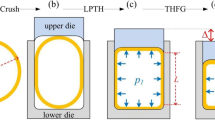Abstract
As an effective method to evaluate the tube hydro-formability, forming limit curve (FLC) has been widely applied on the hydroforming process design. This paper mainly focuses on the study of evaluation of laser seamed tube hydro-formability. Based on the test methods of free bulging and elliptical bulging, hydroforming limit tests of the laser welded tube and the electric resistance welded tube (ERW) have been carried out. The cracking failure characteristics of the seamed tube above during hydroforming are analyzed, and then a new theoretical model which reflects the heterogeneity of material and the non-uniformity of curvature during seamed tube hydroforming is developed to predict FLC for seamed tube hydroforming. The comparison results show that the predicted FLCs are in agreement with the test data. The FLC analysis demonstrates that the laser welded tube exhibits a better hydro-formability than that of the ERW tube with the same size and tubular material, and that the hydro-formability of seamed tube is affected by its diameter and thickness.
Similar content being viewed by others
References
Dohmann F, Hartl C (1996) Hydroforming––a method to manufacture lightweight parts. J Mater Process Technol 60:669–676
Kang SJ, Kim HK, Kang BS (2005) Tube size effect on hydroforming formability. J Mater Process Technol 160:24–33
Koc M, Altan T (2002) Prediction of forming limits and parameters in the tube hydroforming process. Int J Machine Tools Manuf 42:123–138
Keeler SP, Backofen WA (1963) Plastic instability and fracture in sheets stretched over rigid punches. Trans ASM 56:25–48
Goodwin GM (1968) Application of strain analysis to sheet metal forming problems in the press shop. Metall Ital 60:767–774
Farid AM, Tudor B, Guillaume A (2014) Investigation and comparative analysis of plastic instability criteria: application to forming limit diagrams. Int J Adv Manuf Technol 71:1247–1262
Chu E, Xu Y (2008) Influences of generalized loading parameters on FLD predictions for aluminum tube hydroforming. J Mater Process Technol 196:1–9
Nefussi G, Combescure A (2002) Coupled buckling and plastic instability for tube hydroforming. Int J Mech Sci 44:899–914
Chu E, Xu Y (2004) Hydroforming of aluminum extrusion tubes for automotive applications. Part I: buckling, wrinkling and bursting analyses of aluminum tubes. Int J Mech Sci 46:263–283
Jansson M, Nilsson L, Simonsson J (2008) On strain localisation in tube hydroforming of aluminium extrusions. J Mater Process Technol 195:3–14
Kim J, Kang BS, Lee JK (2009) Statistical evaluation of forming limit in hydroforming process using plastic instability combined with FORM. Int J Adv Manuf Technol 42:53–59
Kim J, Kim SW, Park HJ, Kang BS (2006) A prediction of bursting failure in tube hydroforming process based on plastic instability. Int J Adv Manuf Technol 27:518–524
Butuc MC, Gracio JJ, Barat da Rocha A (2003) A theoretical study on forming limit diagrams prediction. J Mater Process Technol 142:714–724
Ramin H, Ghader F, Karen A, Ahmad FD (2010) Application of the hydroforming strain- and stress-limit diagrams to predict necking in metal bellows forming process. Int J Adv Manuf Technol 46:551–561
Kim SW, Song WJ, Kang BS, Kim J (2009) Bursting failure prediction in tube hydroforming using FLSD. Int J Adv Manuf Technol 41:311–322
Chen XF, Yu ZQ, Hou B, Li SH, Lin ZQ (2011) A theoretical and experimental study on forming limit diagram for a seamed tube hydroforming. J Mater Process Technol 211:2012–2021
Kim J, Kim YW, Kang BS, Hwang SM (2004) Finite element analysis for bursting failure prediction in bulge forming of a seamed tube. Finite Elem Anal Des 40:953–963
Davies R, Grant G, Herling D, Smith M, Evert B, Nykerk S, Shoup J (2000) Formability investigation of aluminum extrusions under hydroforming conditions. SAE Tech Paper 1:26–75
Hwang YM, Lin YK, Chuang HC (2009) Forming limit diagrams of tubular materials by bulge tests. J Mater Process Technol 209:5024–5034
Song WJ, Heo SC, Ku TW, Kim J, Kang BS (2010) Evaluation of effect of flow stress characteristics of tubular material on forming limit in tube hydroforming process. Int J Mach Tools Manuf 50:753–764
Li SH, Chen XF, Kong QS, Yu ZQ, Lin ZQ (2012) Study on formability of tube hydroforming through elliptical die inserts. J Mater Process Technol 212:1916–1924
Chen XF, Li SH, Yu ZQ, Lin ZQ (2012) Study on experimental approaches of forming limit curve for tube hydroforming. Int J Adv Manuf Technol 61:87–100
Marciniak Z, Kuczynski K (1967) Limit strains in the processes of stretch-forming sheet metal. Int J Mech Sci 9:613–620
Woo DM, Hawkes PJ (1968) Determination of stress-strain characteristics of tubular materials. J Inst Met 96:357–359
Hwang YM, Lin YK (2006) Analysis of tube bulge forming in an open die considering anisotropic effects of the tubular material. Int J Machine Tools Manuf 46:1921–1928
Shu YS (2005) Mechanics. Peking University Press, Beijing (in Chinese)
Author information
Authors and Affiliations
Corresponding author
Rights and permissions
About this article
Cite this article
Yu, Z., Kong, Q., Ma, C. et al. Theoretical and experimental study on formability of laser seamed tube hydroforming. Int J Adv Manuf Technol 75, 305–315 (2014). https://doi.org/10.1007/s00170-014-6130-y
Received:
Accepted:
Published:
Issue Date:
DOI: https://doi.org/10.1007/s00170-014-6130-y



